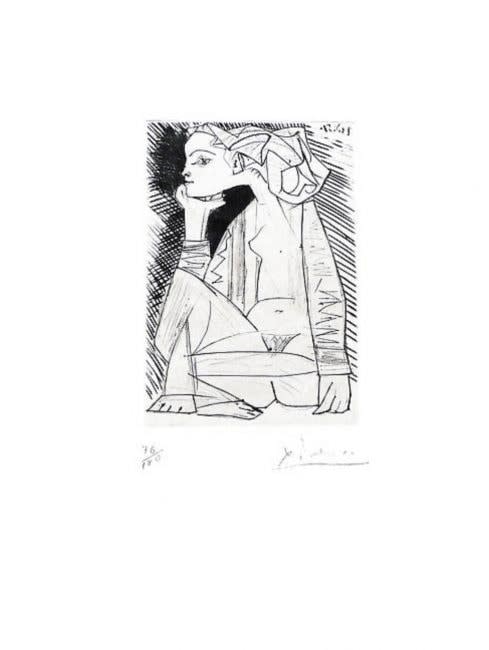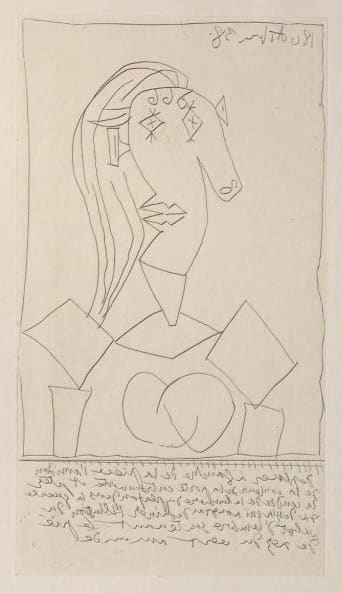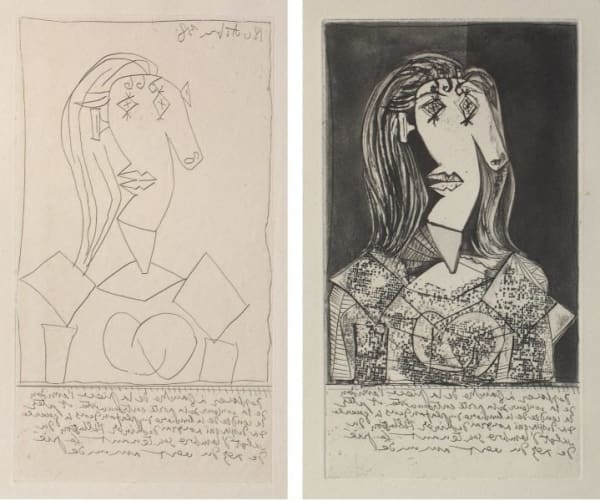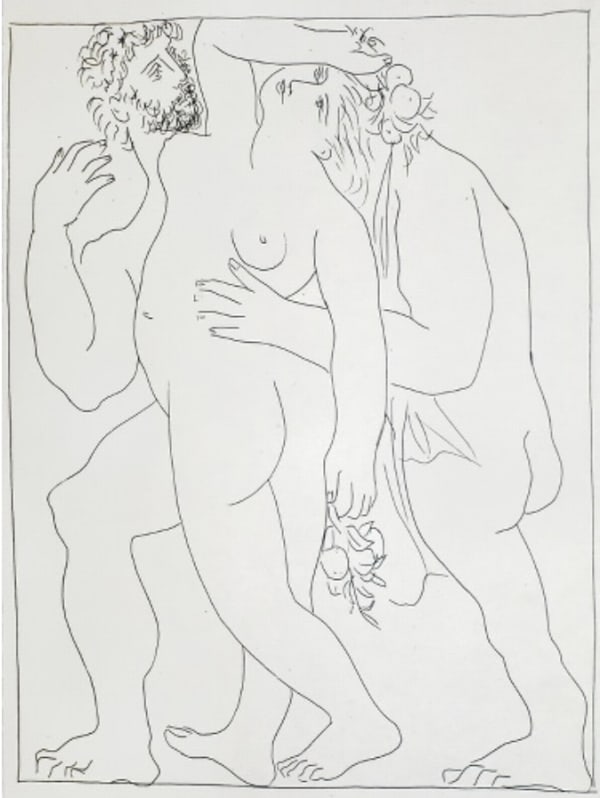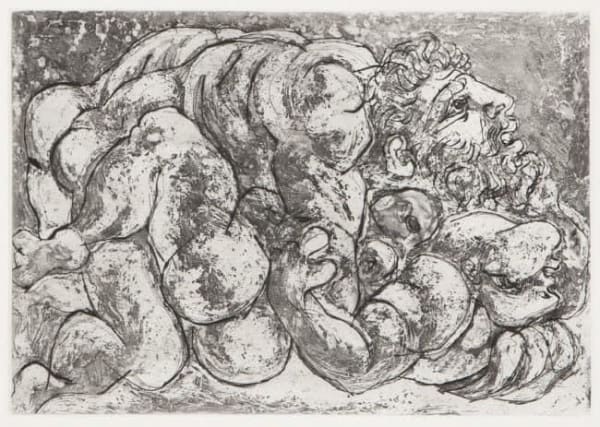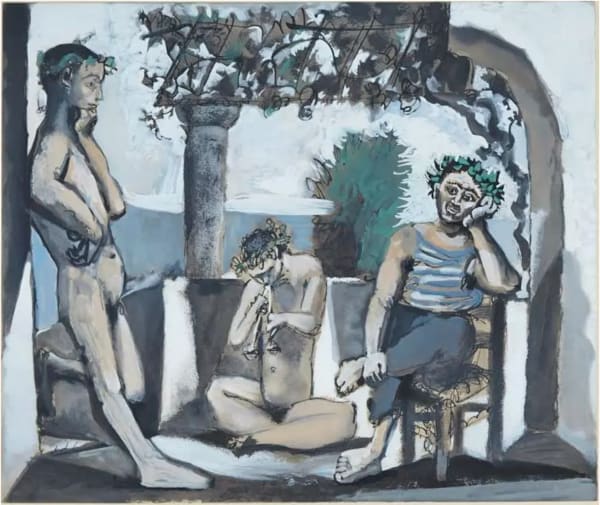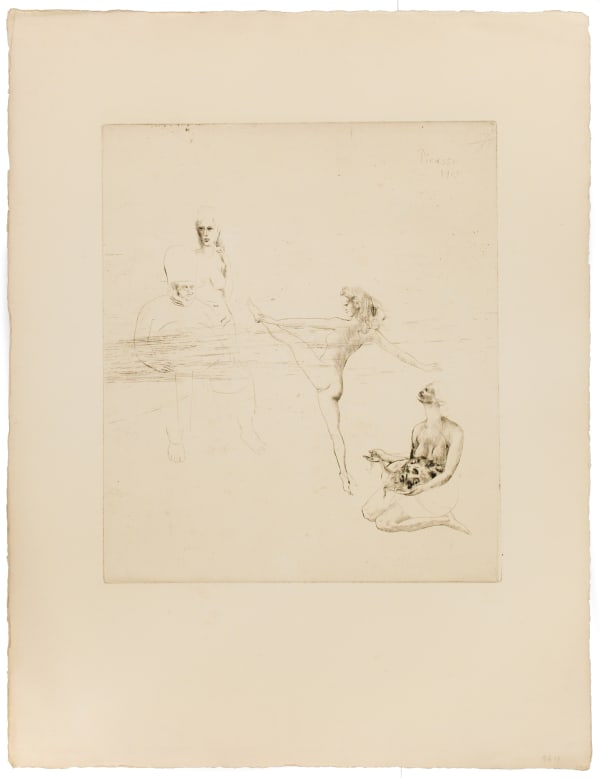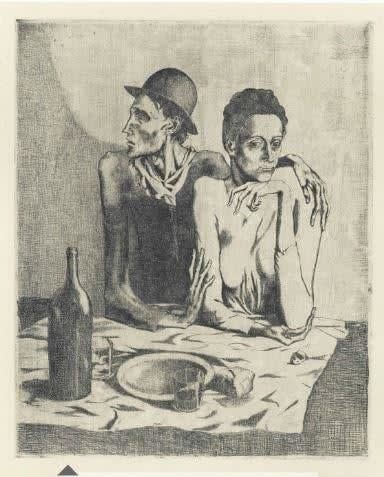
Pablo Picasso
Signed in the plate, bottom right. The edition was not hand-signed.
12.7 x 8.9 cm
Created in 1905, during Picasso’s Rose Period, Saltimbanque au Repos reflects the artist’s fascination with the itinerant circus performers—the saltimbanques—who became central to his artistic imagination in these years. This drypoint is a quiet yet poignant image: a seated clown, legs spread heavily, rests upon a block, his body both monumental and weary. The simplicity of the line captures not only the physical form but also the psychological burden of his subject.
Picasso’s treatment here avoids caricature, instead imbuing the figure with dignity despite his awkward posture. The saltimbanque’s costume, with its frilled collar and pointed cap, signals performance, but the man himself is decidedly offstage, absorbed in rest rather than spectacle. In this way, Picasso humanizes a character who might otherwise have been seen merely as entertainment. His sparse yet confident use of drypoint line emphasizes contour over detail, leaving large areas of unworked plate that echo the emptiness and isolation often associated with the artist’s vision of the circus world.
This sense of solitude, even melancholy, is consistent with the themes of the Rose Period, in which harlequins, clowns, and acrobats often appear as allegories for the artist himself—figures of creativity and fragility, marked by both theatricality and alienation. In Saltimbanque au Repos, Picasso distills these ideas with remarkable economy, using the restraint of drypoint to suggest psychological weight.
The choice of medium itself is significant. Drypoint, with its fine lines and characteristic burr, allows for immediacy and intimacy, qualities that suit the introspective subject matter. The etched lines here feel almost provisional, as though Picasso were sketching directly into the copper plate, reinforcing the impression of an unguarded moment.
Viewed in the broader context of Picasso’s engagement with performers, this work stands as a meditation on vulnerability. The saltimbanque, momentarily freed from the demands of the stage, embodies both the weariness of the body and the enduring resilience of the creative spirit. Picasso, still in his early twenties, channels through this figure both empathy and projection—an image of the artist as laborer, caught between public performance and private fatigue.
For more information or to buy Saltimbanque au Repos by Pablo Picasso, contact our galleries using the form below.
-
 Pablo PicassoTête Homme au Maillot Rayé, 1964
Pablo PicassoTête Homme au Maillot Rayé, 1964 -
 Pablo PicassoEcce Homo, d’Après Rembrandt, 1970
Pablo PicassoEcce Homo, d’Après Rembrandt, 1970 -
 Pablo PicassoFemme Assise en Tailleur, 1951
Pablo PicassoFemme Assise en Tailleur, 1951 -
 Pablo PicassoBuste de Femme (Dora Maar) State IX (Bloch 308), 1938
Pablo PicassoBuste de Femme (Dora Maar) State IX (Bloch 308), 1938 -
 Pablo PicassoBuste de Femme (Dora Maar) State I (Bloch 308), 1938
Pablo PicassoBuste de Femme (Dora Maar) State I (Bloch 308), 1938 -
 Pablo PicassoDora Maar, 1938
Pablo PicassoDora Maar, 1938 -
 Pablo PicassoTete de Femme, 1933
Pablo PicassoTete de Femme, 1933 -
 Pablo PicassoVertumne Poursuit Pomone de son Amour, 1930
Pablo PicassoVertumne Poursuit Pomone de son Amour, 1930 -
 Pablo PicassoAccouplement I, 1933
Pablo PicassoAccouplement I, 1933 -
 Pablo PicassoBacchanale, 1960
Pablo PicassoBacchanale, 1960 -
 Pablo PicassoSalomé, 1905
Pablo PicassoSalomé, 1905 -
 Pablo PicassoLe Repas Frugal, 1904
Pablo PicassoLe Repas Frugal, 1904
Join our mailing list
* denotes required fields
We will process the personal data you have supplied in accordance with our privacy policy (available on request). You can unsubscribe or change your preferences at any time by clicking the link in our emails.
This website uses cookies
This site uses cookies to help make it more useful to you. Find out more about cookies.


